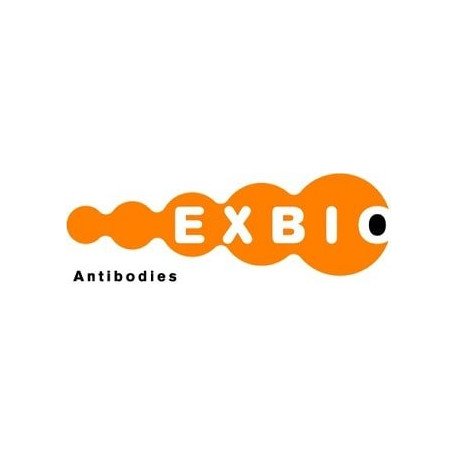Cart 0 Product Products (empty)
No products
To be determined Shipping
0,00 € Total
Prices are tax excluded
Product successfully added to your shopping cart
Quantity
Total
There are 0 items in your cart. There is 1 item in your cart.
Total products (tax excl.)
Total shipping (tax excl.) To be determined
Total (tax excl.)
Data sheet of Mouse Monoclonal to ZAP-70
| Brand | Exbio |
| Product type | Primary antibodies |
| Reactivity | Human, Mouse |
| Clonality | Monoclonal |
More info about Mouse Monoclonal to ZAP-70
| Brand: | Exbio |
| Product no.: | 11-665-C025 |
| Product type: | Primary antibodies |
| Host species: | Mouse |
| Product name: | Mouse Monoclonal to ZAP-70 |
| Antigen: | ZAP-70 |
| Clonality: | Monoclonal |
| Clone: | 1E7.2 |
| Isotype: | IgG1 |
| Immunogen: | A KLH-coupled peptide corresponding to amino acids 282-307 of human ZAP-70 |
| Format: | purified |
| Specificity: | The mouse monoclonal antibody 1E7.2 recognizes ZAP-70, a 70 kDa protein tyrosine kinase expressed in T and NK cells. _x000D_ ZAP-70 is a molecule susceptible to degradation. It is recommended to use freshly prepared cell lysates (protease inhibitors are essential) to avoid non-specific staining of degradation products. _x000D_ This product is for research and in vitro experimental use only. It is not to be used for any other commercial purpose. Use of this product to produce products for sale or for therapeutic or drug discovery purposes is prohibited. In order to obtain a license to use this product for commercial purposes, contact The Regents of the Univessity of California. |
| Categories: | Phosphorylation (Kinases, Phosphatases, Phosphotyrosine) (Human), Phosphorylation (Kinases, Phosphatases, Phosphotyrosine) (Rodent), Phosphorylation (Kinases, Phosphatases, Phosphotyrosine) |
| Concentration: | 1 mg/ml |
| Storage buffer: | Phosphate buffered saline (PBS) with 15 mM sodium azide, approx. pH 7.4 |
| Storage / stability: | Store at 2-8°C. Do not freeze. Do not use after expiration date stamped on vial label. |
| Background: | The ZAP-70 (zeta-associated protein of 70 kDa) tyrosine kinase was identified as a tyrosine phosphoprotein that associates with TCR zeta subunit and undergoes tyrosine phosphorylation following TCR stimulation. ZAP-70 is a Syk family tyrosine kinase primarily expressed in T and NK cells that plays an essential role in signaling through the TCR. TCR-mediated activation of T cells is crucial to the immune response. In humans, ZAP-70 gene mutations resulting in lower ZAP-70 protein expression levels or expression of catalytically inactive ZAP-70 proteins, have been identified. ZAP-70 deficiency results in the absence of mature CD8+ T cells and the prevention of TCR-mediated activation of CD4+ T cells, and it can lead to severe combined immunodeficiency.In patients with chronic lymphocytic leukemia (B-CLL), ZAP-70 expression on B cell was shown to be correlated with disease progression and survival. ZAP-70 contains two N-terminal SH2 domains (Src homology domain 2) and a C-terminal kinase domain. During T cell activation, the binding of ZAP-70 SH2 domains to the phosphorylated zeta subunit on the activated TCR complex causes a colocalization with the Lck tyrosine kinase that phosphorylates ZAP-70 on Tyr493 in the activation loop. ZAP-70 autophosphorylates multiple tyrosines in the region between the SH2 domains and the kinase domain, including the binding sites for additional SH2-containing signaling proteins such as SLP76, LAT, Lck, PLCgamma1, Vav, Shc, Ras-GAP, and Abl. ZAP-70-mediated activation of these downstream effectors leads to the release of intracellular calcium stores, and the transcription of interleukin-2 and other genes important for an immune response. |
| Purity: | > 95% (by SDS-PAGE) |
| Purification: | Purified by protein-A affinity chromatography |
| Product specific references: | *Rossi FM, Del Principe MI, Rossi D, Irno Consalvo M, Luciano F, Zucchetto A, Bulian P, Bomben R, Dal Bo M, Fangazio M, Benedetti D, Degan M, Gaidano G, Del Poeta G, Gattei V: Prognostic impact of ZAP-70 expression in chronic lymphocytic leukemia: mean fluorescence intensity T/B ratio versus percentage of positive cells. J Transl Med. 2010 Mar 8;8:23., *Vroblova V, Vrbacky F, Hrudkova M, Jankovicova K, Schmitzova D, Maly J, Krejsek J, Smolej L: Significant change in ZAP-70 expression during the course of chronic lymphocytic _x000D_ leukemia. Eur J Haematol. 2010 Jun;84(6):513-7., *Sargent RL, Craig FE, Swerdlow SH: Comparison of Bcl-2, CD38 and ZAP-70 Expression in Chronic Lymphocytic Leukemia. Int J Clin Exp Pathol. 2009 Jun 16;2(6):574-82. , *Gachard N, Salviat A, Boutet C, Arnoulet C, Durrieu F, Lenormand B, Leprêtre S, Olschwang S, Jardin F, Lafage-Pochitaloff M, Penther D, Sainty D, Reminieras L, Feuillard J, Béné MC: Multicenter study of ZAP-70 expression in patients with B-cell chronic lymphocytic leukemia using an optimized flow cytometry method. Haematologica. 2008 Feb;93(2):215-23., *Preobrazhensky SN, Bahler DW: Optimization of flow cytometric measurement of ZAP-70 in chronic lymphocytic_x000D_ leukemia. Cytometry B Clin Cytom. 2008 Mar;74(2):118-27., *Del Principe MI, Del Poeta G, Buccisano F, Maurillo L, Venditti A, Zucchetto A, Marini R, Niscola P, Consalvo MA, Mazzone C, Ottaviani L, Panetta P, Bruno A, Bomben R, Suppo G, Degan M, Gattei V, de Fabritiis P, Cantonetti M, Lo Coco F, Del Principe D, Amadori S: Clinical significance of ZAP-70 protein expression in B-cell chronic lymphocytic _x000D_ leukemia. Blood. 2006 Aug 1;108(3):853-61., *Letestu R, Rawstron A, Ghia P, Villamor N, Boeckx N, Boettcher S, Buhl AM, Duerig J, Ibbotson R, Kroeber A, Langerak A, Le Garff-Tavernier M, Mockridge I, Morilla _x000D_ A, Padmore R, Rassenti L, Ritgen M, Shehata M, Smolewski P, Staib P, Ticchioni M, Walker C, Ajchenbaum-Cymbalista F: Evaluation of ZAP-70 expression by flow cytometry in chronic lymphocytic leukemia: A multicentric international harmonization process. Cytometry B Clin Cytom. 2006 Jul 15;70(4):309-14., *And many other. |
| Related products: | - Rabbit Polyclonal to Francisella tularensis ssp. holarctica antigen FTL0187 - Rabbit Polyclonal to Akt1 / PKB - Rabbit Polyclonal to CtBP1 / BARS |
| Shipping condition: | Room temperature |


